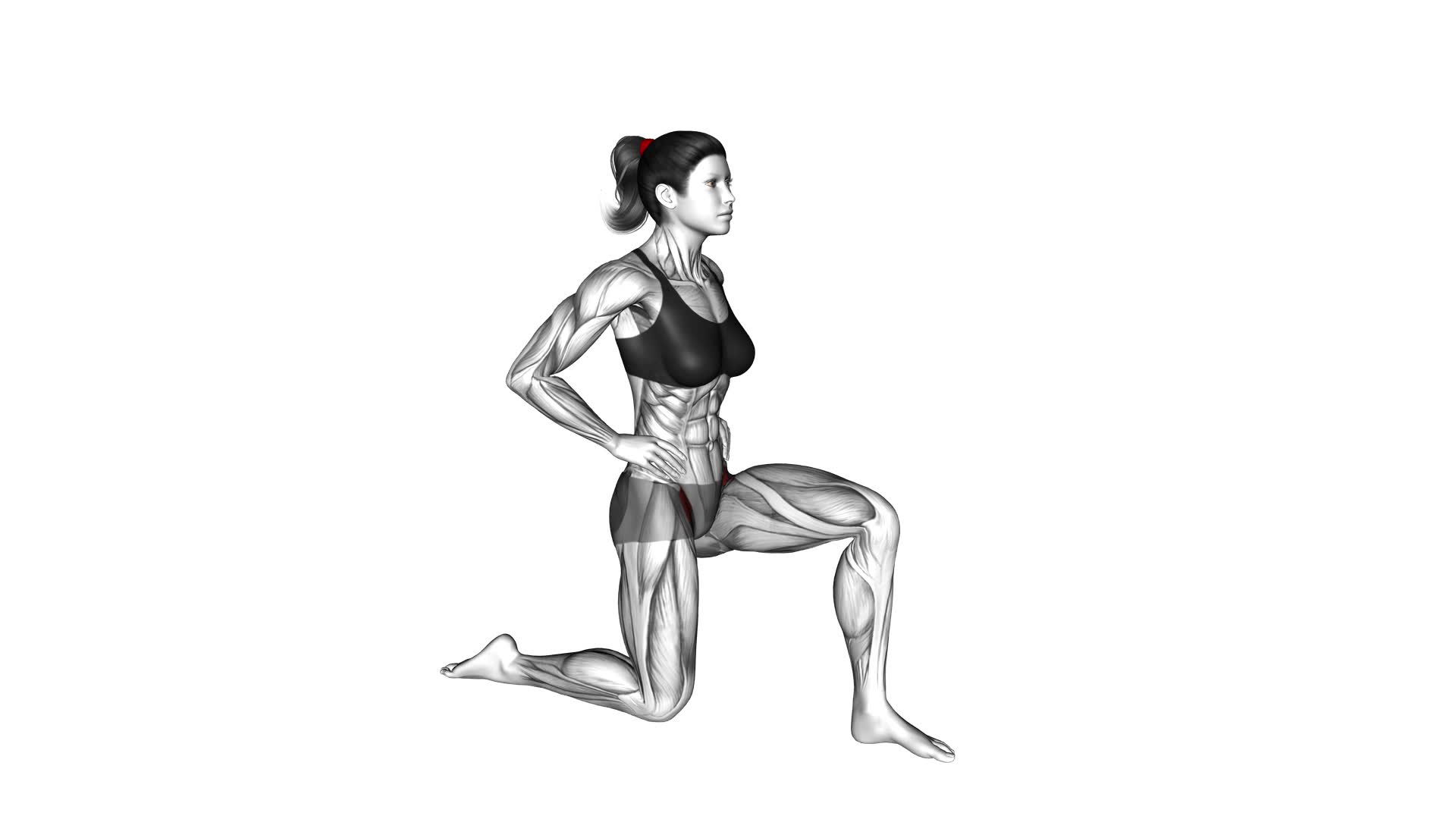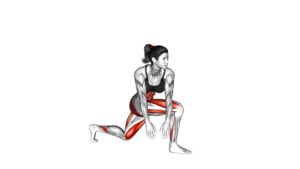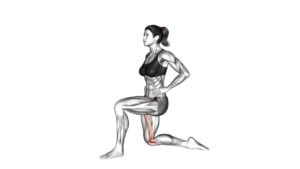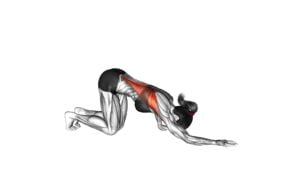Kneeling Iliopsoas Stretch (female) – Video Exercise Guide & Tips

Are you looking for an effective stretch to target your iliopsoas muscles? Look no further!
Watch This Exercise Video
In this video exercise guide, we'll show you the proper technique for the kneeling iliopsoas stretch. Discover the benefits of this stretch, common mistakes to avoid, and helpful tips to maximize your results.
Whether you're a beginner or have limited mobility, we've got modifications for you.
Get ready to incorporate the kneeling iliopsoas stretch into your fitness routine for improved flexibility and mobility.
Let's get started!
Key Takeaways
- The kneeling iliopsoas stretch improves hip flexor flexibility and reduces lower back pain.
- Proper technique includes keeping the back upright, engaging core muscles, and slowly leaning forward.
- To maximize the stretch, avoid arching the lower back, modify the stretch with hand support or advanced variations, and listen to your body.
- Common mistakes to avoid include arching the back, using momentum instead of controlled movements, and not maintaining an upright posture.
Benefits of the Kneeling Iliopsoas Stretch
One major benefit of the kneeling iliopsoas stretch is that it helps improve hip flexor flexibility. The hip flexors are a group of muscles located at the front of your hip joint, and they play a crucial role in allowing you to bend your hip and bring your knee towards your chest.
When these muscles become tight or shortened, it can lead to decreased range of motion and increased stress on the lower back. By regularly performing the kneeling iliopsoas stretch, you can effectively lengthen and stretch these muscles, which can help improve flexibility and reduce lower back pain.
This stretch specifically targets the iliopsoas muscle, which is the primary hip flexor. To perform the stretch, kneel on one knee while keeping the other foot flat on the ground, and then gently lean forward, keeping your back straight, until you feel a stretch in the front of your hip. Hold this position for about 30 seconds and repeat on the other side.
Incorporating this stretch into your routine can be highly beneficial for improving hip flexor flexibility and alleviating lower back pain.
Proper Technique for the Kneeling Iliopsoas Stretch
To properly perform the kneeling iliopsoas stretch, you should begin by positioning yourself on one knee while keeping the other foot flat on the ground. Here are the steps to follow for the proper technique:
- Place a mat or cushion under your kneeling knee for comfort.
- Keep your back upright and engage your core muscles.
- Slowly lean forward, shifting your weight onto your front foot while maintaining balance.
- You should feel a stretch in the front of your hip and thigh of the kneeling leg.
To maximize the effectiveness of the kneeling iliopsoas stretch, it's important to maintain proper form and technique. Here are some tips to keep in mind:
- Avoid arching your lower back or leaning too far forward, as this can strain the lower back and reduce the stretch in the iliopsoas.
- Modify the stretch by placing your hands on your front knee for support if needed.
- For advanced variations of the kneeling iliopsoas stretch, you can lift the back foot off the ground and hold onto it with your hand, increasing the stretch on the iliopsoas muscles.
Remember to listen to your body and adjust the stretch according to your comfort level. By practicing the proper technique and incorporating modifications or advanced variations, you can effectively stretch and strengthen your iliopsoas muscles.
Common Mistakes to Avoid
To ensure proper form during the kneeling iliopsoas stretch, it's important to avoid common mistakes.
One common mistake is arching your back instead of keeping it straight, which can strain your lower back.
Another mistake to avoid is using momentum to swing your leg forward instead of using controlled movements, as this can lead to injury.
Proper Form Demonstration
When performing the kneeling iliopsoas stretch, it's important to be aware of common mistakes to avoid. To ensure proper form, here are some key points to keep in mind:
- Maintain an upright posture throughout the stretch, avoiding any excessive leaning forward or backward.
- Engage your core muscles to stabilize your spine and pelvis, preventing any unnecessary strain.
- Keep your kneeling leg at a 90-degree angle, with the knee directly above the ankle.
- Gradually increase the stretch by leaning slightly forward, feeling a gentle pull in the front of your hip.
By following these form modifications, you can maximize the effectiveness of the kneeling iliopsoas stretch while minimizing the risk of injury.
Injury Prevention Tips
To prevent injuries and avoid common mistakes, it's important for you to consistently maintain proper form while performing the kneeling iliopsoas stretch. One key aspect of injury prevention is incorporating dynamic warm-up exercises before stretching. These exercises help increase blood flow to the muscles and prepare them for the stretch.
Additionally, it's important to focus on effective stretches that improve flexibility. The kneeling iliopsoas stretch is a great choice as it targets the hip flexors and helps improve their range of motion. By regularly incorporating this stretch into your routine, you can prevent injuries and improve your overall flexibility.
Now, let's move on to some tips for getting the most out of the stretch.
Tips for Getting the Most Out of the Stretch
Maximize your stretch by maintaining proper form and engaging your core muscles. Here are some tips for getting the most out of the kneeling iliopsoas stretch:
- Keep your back straight: Maintaining a straight back will help target the iliopsoas muscles more effectively. Avoid arching or rounding your back.
- Engage your core: By activating your core muscles, you can enhance the effectiveness of the stretch. This will also help stabilize your body during the exercise.
- Gradually increase the stretch: Start with a gentle stretch and gradually increase the intensity over time. This will allow your muscles to adapt and prevent injury.
- Experiment with variations: Once you have mastered the basic kneeling iliopsoas stretch, try different variations to challenge your muscles further. For advanced practitioners, you can add resistance bands or incorporate a twist to engage different muscle fibers.
By following these tips, you can maximize the effectiveness of the kneeling iliopsoas stretch and target your hip flexors more efficiently. Remember to listen to your body and adjust the intensity as needed.
Happy stretching!
Modifications for Beginners or Those With Limited Mobility
Looking to modify the kneeling iliopsoas stretch for beginners or those with limited mobility? There are several modification options and alternative stretches you can try.
If you find it difficult to kneel on the ground, you can perform the stretch while sitting on a chair. Sit on the edge of the chair with your feet flat on the ground. Place one foot slightly forward and lift the other foot off the ground, keeping your knee bent. Lean forward from your hips until you feel a stretch in the front of your hip. Hold for 30 seconds, then switch sides.
Another modification option is to use a yoga block or a cushion for support. Kneel on the ground and place the block or cushion under your back knee for added comfort. This can help reduce the intensity of the stretch while still targeting the iliopsoas muscle.
If the kneeling position is too challenging, you can also try alternative stretches such as the standing hip flexor stretch or the supine hip flexor stretch. These stretches target the same muscle group but in a different position.
Incorporating the kneeling iliopsoas stretch into your fitness routine can help improve hip flexibility and reduce tightness in the hip flexors.
Incorporating the Kneeling Iliopsoas Stretch Into Your Fitness Routine
To incorporate the kneeling iliopsoas stretch into your fitness routine, try performing it at the beginning or end of your workout to improve hip flexibility and reduce tightness in the hip flexors. This stretch can be a great addition to your routine, providing various benefits and helping you achieve your fitness goals.
Here are some ways you can incorporate the kneeling iliopsoas stretch into your routine:
- Perform the stretch before a lower body workout to warm up your hip flexors and increase range of motion.
- Include the stretch after a long period of sitting to counteract the effects of prolonged sitting and prevent tightness in the hip flexors.
- Use the stretch as a cool down after an intense lower body workout to promote relaxation and release tension in the hip flexors.
- Add variations of the stretch, such as reaching overhead or adding a side stretch, to further target different muscle groups and improve overall flexibility.
Frequently Asked Questions
How Long Should I Hold the Kneeling Iliopsoas Stretch?
To get the most out of the kneeling iliopsoas stretch, it's important to know the proper form and how long to hold it.
Holding the stretch for about 20-30 seconds is a good starting point. This allows your muscles to lengthen and improve flexibility.
The benefits of this stretch include relieving hip tightness and improving posture. Remember to keep your back straight and engage your core for the best results.
Can the Kneeling Iliopsoas Stretch Help With Lower Back Pain?
The kneeling iliopsoas stretch can be beneficial for relieving lower back pain. By stretching the iliopsoas muscles, which connect the lower back to the hips, you can improve flexibility and mobility in the area.
To properly perform this stretch, kneel on one knee with the other foot in front, and lean forward while keeping your back straight.
Remember to listen to your body and avoid any pain or discomfort to prevent injury.
Is It Normal to Feel Discomfort or Tightness During the Stretch?
Feeling discomfort or tightness during the kneeling iliopsoas stretch is normal. It's a sign that your muscles are being stretched and worked. Remember to listen to your body and only go as far as you can without causing pain.
This stretch can help relieve lower back pain by targeting the iliopsoas muscles, which can become tight and contribute to discomfort.
With regular practice, you may experience increased flexibility and reduced tension in your lower back.
Can the Kneeling Iliopsoas Stretch Be Done Before or After a Workout?
Yes, the kneeling iliopsoas stretch can be done both before and after a workout.
Doing it before a workout can help warm up your hip flexors and improve your range of motion.
It can also be done after a workout to help cool down and stretch out your muscles.
Remember to listen to your body and modify the stretch if you feel any discomfort.
Are There Any Variations of the Kneeling Iliopsoas Stretch That Target Different Muscle Groups?
There are variations of the kneeling iliopsoas stretch that target different muscle groups. These variations can help you to stretch and strengthen other areas of your body.
By adjusting the position of your legs or adding different movements, you can focus on different muscles such as the hip flexors, glutes, or hamstrings.
These variations can provide additional benefits and help you to customize your stretching routine based on your specific needs and goals.
Conclusion
Incorporating the kneeling iliopsoas stretch into your fitness routine can provide numerous benefits. This stretch can improve flexibility, reduce lower back pain, and enhance hip mobility. By following the proper technique and avoiding common mistakes, you can maximize the effectiveness of this stretch. Beginners or those with limited mobility can make modifications to suit their needs.
So why not give the kneeling iliopsoas stretch a try and enjoy the benefits it brings to your overall fitness and well-being?

Author
Years ago, the spark of my life’s passion ignited in my mind the moment I stepped into the local gym for the first time. The inaugural bead of perspiration, the initial endeavor, the very first surge of endorphins, and a sense of pride that washed over me post-workout marked the beginning of my deep-seated interest in strength sports, fitness, and sports nutrition. This very curiosity blossomed rapidly into a profound fascination, propelling me to earn a Master’s degree in Physical Education from the Academy of Physical Education in Krakow, followed by a Sports Manager diploma from the Jagiellonian University. My journey of growth led me to gain more specialized qualifications, such as being a certified personal trainer with a focus on sports dietetics, a lifeguard, and an instructor for wellness and corrective gymnastics. Theoretical knowledge paired seamlessly with practical experience, reinforcing my belief that the transformation of individuals under my guidance was also a reflection of my personal growth. This belief holds true even today. Each day, I strive to push the boundaries and explore new realms. These realms gently elevate me to greater heights. The unique combination of passion for my field and the continuous quest for growth fuels my drive to break new ground.



